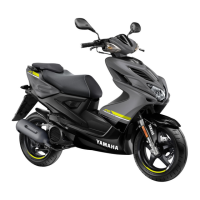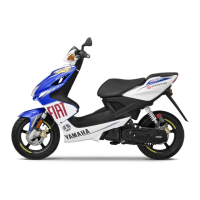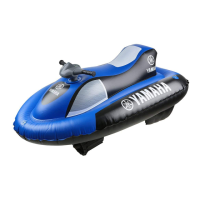Do you have a question about the Yamaha AEROX NS50 and is the answer not in the manual?
Owner's responsibility for safe operation and essential safe riding practices.
Importance of wearing safety helmet, face shield, gloves, and protective clothing.
Safety precautions for carbon monoxide and safe loading of cargo.
Using genuine accessories and risks of aftermarket parts/modifications.
Tire/rim considerations, scooter transport, and further safe riding tips.
Advice on carrying luggage safely and avoiding overloading the scooter.
Identification of main components on the left side of the scooter.
Identification of main components on the right side of the scooter.
Identification of handlebar controls and instrument panel features.
How to use the main switch/steering lock for ignition, lighting, and locking steering.
Explanation of various indicator lights and warning signals on the instrument panel.
Meaning and function of fuel level and coolant temperature warning lights.
Explanation of the speedometer, odometer, and fuel meter.
Description and operation of the multi-function display and its self-test.
Modes for odometer/tripmeter and operation of the fuel gauge.
Function of the self-diagnosis device and layout of handlebar switches.
Detailed explanation of dimmer, turn signal, horn, and start switches.
How to operate the front and rear brake levers.
How to remove and install fuel and 2-stroke engine oil tank caps.
Safety guidelines for fueling and recommended fuel type.
Catalytic converter info and 2-stroke engine oil requirements.
How to use the kickstarter and access the seats.
Information on the storage compartment, including load limits and precautions.
How to adjust the spring preload on the shock absorber assembly.
Checking fuel, oil, coolant, and brake systems before operation.
Checking wheels, tires, chassis, electrical systems, and battery.
Procedure for starting the engine when it is cold.
Steps for starting off, adjusting speed, and proper braking techniques.
Tips for fuel economy and guidelines for engine break-in period.
Instructions for parking the scooter safely to prevent accidents and damage.
Crucial safety warnings related to performing vehicle maintenance.
Scheduled maintenance for emission control components.
Chart outlining general maintenance tasks and lubrication intervals.
Instructions for removing and installing the cowling and panel for maintenance.
How to check, clean, and replace the spark plug.
Procedure for checking and changing the final transmission oil.
How to check coolant level and information on changing coolant.
Procedure for cleaning the air filter element, including frequency and method.
Guidance on carburetor adjustment and checking throttle grip free play.
Importance of tire condition, tread depth, and correct air pressure.
Points to note regarding cast wheel inspection for performance and safety.
How to check and adjust the free play of the front and rear brake levers.
How to check the wear on front and rear brake pads.
Procedure for checking the brake fluid level and notes on fluid type.
Guidance on when and how to change brake fluid and brake hoses.
Lubrication of throttle grip/cable and front/rear brake levers.
How to check and lubricate the centerstand for smooth operation.
How to check the condition and operation of the front fork.
How to check steering bearings and wheel bearings for wear or play.
Information on battery maintenance, checks, and storage.
How to replace a blown fuse, including safety precautions.
Step-by-step instructions for replacing the headlight bulb.
How to replace tail/brake light and turn signal light bulbs.
Troubleshooting the license plate light and replacing auxiliary bulbs.
Tips on using troubleshooting charts and using genuine Yamaha parts.
Diagnostic flowcharts for fuel, compression, ignition, and battery problems.
Steps to take if the engine overheats, including safety precautions.
Special precautions for cleaning matte colored parts.
Steps for proper cleaning and care of the scooter's exterior and components.
Cleaning procedures after normal use, rain, or exposure to salt.
How to properly store the scooter for short periods.
Detailed steps for preparing the scooter for long-term storage.
Overall dimensions, wheelbase, ground clearance, and weight of the scooter.
Specifications for tires, brake system, and front/rear suspension.
Details on ignition, charging, battery, and lighting system specifications.
Specifications for indicator lights, main fuse, and battery model.
Locating and recording vehicle identification number and model label information.
Owner's responsibility for safe operation and essential safe riding practices.
Importance of wearing safety helmet, face shield, gloves, and protective clothing.
Safety precautions for carbon monoxide and safe loading of cargo.
Using genuine accessories and risks of aftermarket parts/modifications.
Tire/rim considerations, scooter transport, and further safe riding tips.
Advice on carrying luggage safely and avoiding overloading the scooter.
Identification of main components on the left side of the scooter.
Identification of main components on the right side of the scooter.
Identification of handlebar controls and instrument panel features.
How to use the main switch/steering lock for ignition, lighting, and locking steering.
Explanation of various indicator lights and warning signals on the instrument panel.
Meaning and function of fuel level and coolant temperature warning lights.
Explanation of the speedometer, odometer, and fuel meter.
Description and operation of the multi-function display and its self-test.
Modes for odometer/tripmeter and operation of the fuel gauge.
Function of the self-diagnosis device and layout of handlebar switches.
Detailed explanation of dimmer, turn signal, horn, and start switches.
How to operate the front and rear brake levers.
How to remove and install fuel and 2-stroke engine oil tank caps.
Safety guidelines for fueling and recommended fuel type.
Catalytic converter info and 2-stroke engine oil requirements.
How to use the kickstarter and access the seats.
Information on the storage compartment, including load limits and precautions.
How to adjust the spring preload on the shock absorber assembly.
Checking fuel, oil, coolant, and brake systems before operation.
Checking wheels, tires, chassis, electrical systems, and battery.
Procedure for starting the engine when it is cold.
Steps for starting off, adjusting speed, and proper braking techniques.
Tips for fuel economy and guidelines for engine break-in period.
Instructions for parking the scooter safely to prevent accidents and damage.
Crucial safety warnings related to performing vehicle maintenance.
Scheduled maintenance for emission control components.
Chart outlining general maintenance tasks and lubrication intervals.
Instructions for removing and installing the cowling and panel for maintenance.
How to check, clean, and replace the spark plug.
Procedure for checking and changing the final transmission oil.
How to check coolant level and information on changing coolant.
Procedure for cleaning the air filter element, including frequency and method.
Guidance on carburetor adjustment and checking throttle grip free play.
Importance of tire condition, tread depth, and correct air pressure.
Points to note regarding cast wheel inspection for performance and safety.
How to check and adjust the free play of the front and rear brake levers.
How to check the wear on front and rear brake pads.
Procedure for checking the brake fluid level and notes on fluid type.
Guidance on when and how to change brake fluid and brake hoses.
Lubrication of throttle grip/cable and front/rear brake levers.
How to check and lubricate the centerstand for smooth operation.
How to check the condition and operation of the front fork.
How to check steering bearings and wheel bearings for wear or play.
Information on battery maintenance, checks, and storage.
How to replace a blown fuse, including safety precautions.
Step-by-step instructions for replacing the headlight bulb.
How to replace tail/brake light and turn signal light bulbs.
Troubleshooting the license plate light and replacing auxiliary bulbs.
Tips on using troubleshooting charts and using genuine Yamaha parts.
Diagnostic flowcharts for fuel, compression, ignition, and battery problems.
Steps to take if the engine overheats, including safety precautions.
Special precautions for cleaning matte colored parts.
Steps for proper cleaning and care of the scooter's exterior and components.
Cleaning procedures after normal use, rain, or exposure to salt.
How to properly store the scooter for short periods.
Detailed steps for preparing the scooter for long-term storage.
Overall dimensions, wheelbase, ground clearance, and weight of the scooter.
Specifications for tires, brake system, and front/rear suspension.
Details on ignition, charging, battery, and lighting system specifications.
Specifications for indicator lights, main fuse, and battery model.
Locating and recording vehicle identification number and model label information.
| Displacement | 49cc |
|---|---|
| Bore x Stroke | 40.0 mm x 39.2 mm |
| Ignition | CDI |
| Front Suspension | Telescopic fork |
| Rear Suspension | Unit Swing |
| Engine Type | 2-stroke, single cylinder |
| Fuel System | Carburettor |
| Starting System | Electric and kick |
| Transmission | Automatic |
| Front Brake | Disc |
| Rear Brake | Drum |











